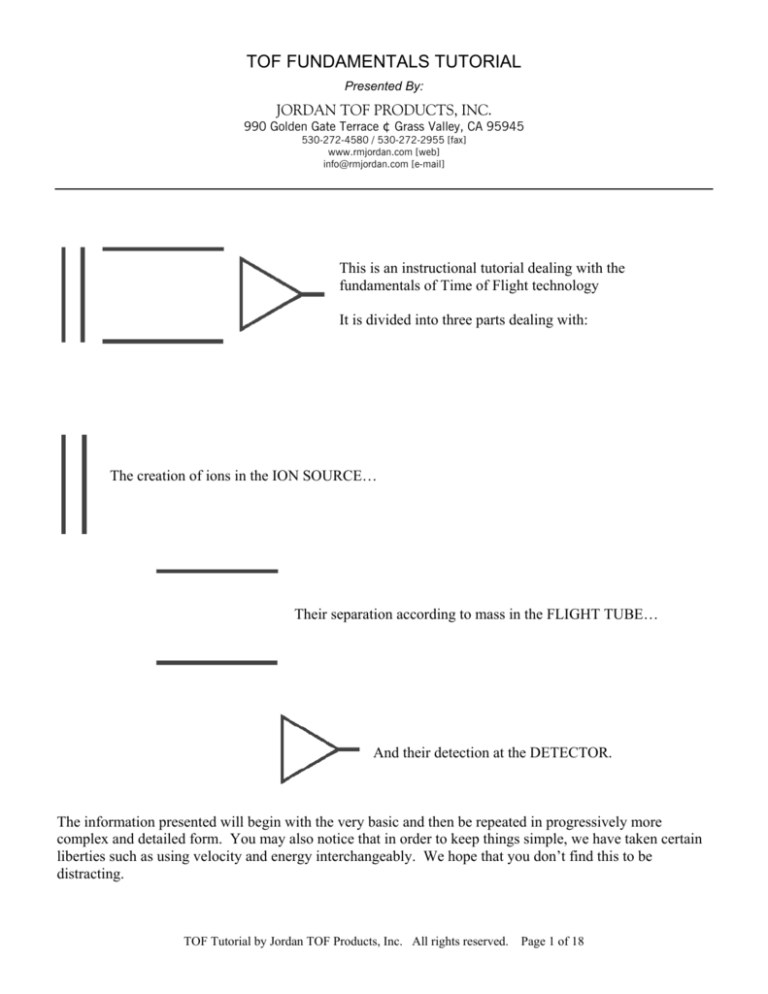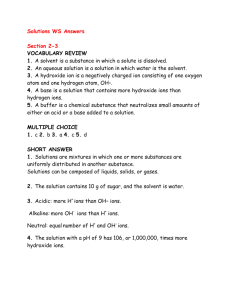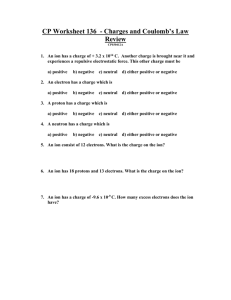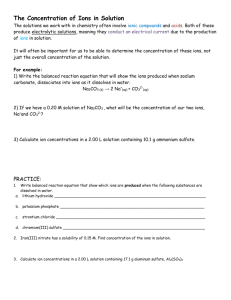
TOF FUNDAMENTALS TUTORIAL
Presented By:
JORDAN TOF PRODUCTS, INC.
990 Golden Gate Terrace ‚ Grass Valley, CA 95945
530-272-4580 / 530-272-2955 [fax]
www.rmjordan.com [web]
info@rmjordan.com [e-mail]
This is an instructional tutorial dealing with the
fundamentals of Time of Flight technology
It is divided into three parts dealing with:
The creation of ions in the ION SOURCE…
Their separation according to mass in the FLIGHT TUBE…
And their detection at the DETECTOR.
The information presented will begin with the very basic and then be repeated in progressively more
complex and detailed form. You may also notice that in order to keep things simple, we have taken certain
liberties such as using velocity and energy interchangeably. We hope that you don’t find this to be
distracting.
TOF Tutorial by Jordan TOF Products, Inc. All rights reserved. Page 1 of 18
If an atom or molecule loses…
Or gains an electron, it will have an electrical charge:
A positive charge if it loses,
or a negative charge if it gains
an electron. The resulting charged atom or molecule is called an ion. This process is called ionization.
It is because of ionization that mass analysis is made possible.
If an ion is created in an electrical field, it will accelerate in the direction opposite
to its polarity.
In this case, a positive ion accelerates away from the positive electrode.
If the negative electrode is replaced with a grid, the ion will pass through it and
leave the ion source. In this very simple ion source, ions are created in a field and
extracted through a grid which is therefore called the extraction grid. The
electrode opposite the extraction grid repels the ions and is therefore called the
repeller plate.
TOF Tutorial by Jordan TOF Products, Inc. All rights reserved. Page 2 of 18
Ions can be created in several ways: One way is by electron bombardment in which an electron collides with
a molecule,
causing it to lose…
or gain an electron
Another way is to expose the molecules to high intensity laser light. The energy of
the laser causes it to become excited, and throw off an electron.
Still another way is to charge two surfaces to a very high voltage
difference. This causes the gas between them to break down into a
plasma; or ion cloud.
Even though all of these ways can be used to create ions, the ions are not suitable
for analysis unless they are all ejected from the ion source with the same starting
time.
This is easy to do with a pulsed laser
which can be turned on and off very
rapidly so that it only creates ions
during time “t”.
This results in a group of ions
being ejected during time “t”
only
TOF Tutorial by Jordan TOF Products, Inc. All rights reserved. Page 3 of 18
Using electrons or plasma is more complicated. Since the ionizing process cannot be started
and stopped quickly, the start time is controlled with an electrical pulse.
To do this, ions are created while the repeller plate and extraction grid are at the same voltage
potential.
At the
start moving
proper time, the voltages can be switched on rapidly, causing all the ions to
at the same time.
The
instrument which does the rapid switching is called a pulser, or pulse
generator. Timing circuits are used to coordinate the start time with other events in the experiment.
While the ions are being extracted, the ionizing process is stopped so that only the
ions which were present at the starting pulse will be extracted.
Notice that this results in a small group of ions which are close together, as if they
had been made by a laser.
So far we have discussed ion formation and extraction only. For use in a real instrument, some additional
elements, called ion optics are usually added.
First is an accelerating grid. Its purpose is to accelerate the extracted ions to the correct velocity for entry
into the flight tube. The voltage on this grid, A3 is about ten times the difference between that on the
repeller plate A1 and extraction grid, A2.
Therefore, if A2 is 100 volts more negative than A1, then A3 will be 1000 volts more negative than A2.
Now lets summarize what we’ve said so far. When a static molecule is Ionized in the
potential field between repeller plate and extraction grid, it…
immediately begins to move toward
and through the extraction grid.
TOF Tutorial by Jordan TOF Products, Inc. All rights reserved. Page 4 of 18
It then enters a much stronger field
which causes it to accelerate……….Into the flight tube
An ionizing pulse of 10 nanoseconds will yield ion packets which are at
least 10 nanoseconds wide.
Since this packet width is determined by time, it is known as time or
temporal distribution. One way to compensate for temporal distribution is
referred to as ion storage, and will be referred to later.
Ion packet width is also determined by the position of the ions when first created or
accelerated. This variation in position is known as initial spacial distribution.
Lets look at three ions which are created in
an ion source.
One of them is close to the extraction grid,
So it will leave first, but it will be moving slower
The middle one will leave later, but
will be moving faster….
The farthest one will leave last, but will be moving even
faster.
This variation in their velocities is called energy distribution.
TOF Tutorial by Jordan TOF Products, Inc. All rights reserved. Page 5 of 18
After traveling some distance, F1, the late, faster ions just
catch up with the slower ones. This point, F, is known as the
primary focal point.
Adjusting the grid voltages and spacing to control the location of this point is called energy focusing. The
focusing shown in this diagram is also known as first order focusing. We will return to this later, and
discuss ways to take advantage of it. Elements can be added to the ion source for the purpose of extending
or otherwise controlling the focal point. This has been referred to as second order focusing. It will be
discussed later as it relates to resolution.
Until now we have been considering molecules, which were static when ionized. An ion source must also
deal with another kind of energy, called transverse energy.
If an ion is moving at the time of its extraction pulse, it’s
initial velocity can cause it to drift away from the axis of
the flight tube.
To counteract this, steering plates can be added. A
positive voltage on a plate which is opposite the
transverse velocity will repel a positive ion back onto a
desired course. Likewise, a negative voltage on the other
plate will have the same effect. It is sometimes best to
apply both of them at the same time to keep the field
symmetrical.
Now that we know the basic ion source elements and how they work, lets look at them in more detail.
The spacing, (d) of the plates must be kept small compared to the width, (w).
TOF Tutorial by Jordan TOF Products, Inc. All rights reserved. Page 6 of 18
This prevents penetration by outside electric
fields
which would distort the shape of the ionization
and extraction fields.
This ratio is usually 3 or 4 to one
Sometimes it is necessary to make them narrower or farther apart. To allow
this, the edges of the plates can be bent inward…
This makes them appear wider electrically.
This can also allow close proximity to an
EGUN…
Or a sample probe
The size of source elements must be controlled to minimize collisions
with
ions.
For instance, if the extraction grid is larger than the acceleration grid…
Ions will impact around the edge of the acceleration grid
TOF Tutorial by Jordan TOF Products, Inc. All rights reserved. Page 7 of 18
This will form a coating on the face of the grid plate. They can also
generate secondary ions, electrons and other collision products which can
cause electrical noise and distortion.
For this reason, grids are made with approximately equal diameters in
order to collimate the ion packet.
If it is desirable to reduce the diameter, such as for a pressure differential,
a cone shaped orifice can be used. It is sometimes called a skimmer.
Shown in close up we can see that when ions do
hit the skimmer, they will be “around the corner”
where contamination and noise are away from
the ion beam
TOF Tutorial by Jordan TOF Products, Inc. All rights reserved. Page 8 of 18
THE FLIGHT TUBE (Ion Separation)
The flight tube is usually a vacuum enclosure, free of electrical fields, between the ion source and the
detector. It is sometimes referred to as a “field free drift region”.
The ions which are under study exit the ion source
(s) and enter the flight tube with the proper
velocity and direction to arrive at the detector (d)
The flight tube does not usually interact with the
ion packets along their flight path (L)
If the ions are created at a positive voltage and
accelerated to ground potential, the flight tube can
be a simple pipe.
Sometimes the ion source must be at ground, or a
different potential from the flight tube. So a
shield tube is used to protect the ion packets from
the electrical field of the flight tube. This tube is
often called a liner. It is usually made from sheet
metal and perforated to improve pumping.
FLIGHT TUBE PUMPING
Adequate pumping is required to prevent the ions from colliding with molecules on the way to the detector.
Pumping requirements can be determined by considering several factors.
The detector which is usually a microchannel
plate, must be operated below 1 X 10 –5 torr.
This usually determines the maximum allowable
pressure in the flight tube.
Often the source region is at a suitably low
pressure. In this case the flight tube is pumped by
the opening into the source region.
TOF Tutorial by Jordan TOF Products, Inc. All rights reserved. Page 9 of 18
If the source pressure is higher than required by the flight tube, supplemental pumping is used to remove inflow of gas from the source chamber.
This is suitable for moderate increases in source
pressure…
But for higher pressure it is necessary
to put a restriction, or pumping impedance
between source and flight tube to reduce this
flow.
Now let us look at the relationship between the size of the restriction, the speed of the pump and the
resulting pressure.
A restriction which is 3mm in diameter will allow about 1 liter/sec to pass into the flight tube. Thus, if the
exhaust pump has a net speed of 10 liters/sec., the pressure in the flight tube will be about 1/10th that in the
source. More practical values are a 10mm diameter orifice and 80 liters/sec pump to yield a similar
pressure differential.
It can be seen that the upper allowable limit to the source pressure is determined by the maximum size of
the vacuum pump on the flight tube.
To control this limit it is sometimes possible to
differentially pump the source region by using a
shroud (s).
Now the molecular inlet expands into the source
region across a primary impedance (1) with a
secondary impedance (2) into the flight tube.
If the primary impedance (p) can be made small
enough, the source pump and secondary
impedance can be deleted.
TOF Tutorial by Jordan TOF Products, Inc. All rights reserved. Page 10 of 18
Now all the pressure differential is at the primary impedance, and the flight tube pump becomes the main
pump for the mass spectrometer portion of the experiment.
We will look at this in more detail later when we discuss molecular beams. We have wandered a little bit,
so lets get back to what happens in the flight tube.
MASS SEPARATION
Ions are pulsed into the flight tube in short, well defined packets. All the ions are given the same energy in
the source. Since the light ones were kicked just as hard as the heavy ones, they will travel faster. The term
“kick” may not sound very scientific, but it helps us to understand why their velocities are different.
Since they are traveling at different velocities, the ion packets become strung out as they travel down the
flight tube. The light ions (a) in front, and the heavier ones (b) in back. Given sufficient flight time, the
ions become separated into individual packets (c) by mass number. The detector amplifies them
sequentially, and each packet becomes a mass peak.
THE DETECTOR (The conversion of ion packets into peaks)
This is a brief, functional description of the detector. Until now we have shown the detector horizontally as
a symbol at the end of the flight tube.
So now we will rotate it
90 degrees…
and show it in cross section
so that we can see what’s inside.
The top element (a) is the entry grid. It is normally at the same voltage as the flight tube liner. It serves two
functions. The first is to act as an exact end in space for the drift region. This is the finish line for the ions
in their trip down the flight tube. The second function of the entry grid is to shield the flight tube from the
high voltages that are used in the detector. This insures a field free drift region all the way to the end of the
flight tube.
TOF Tutorial by Jordan TOF Products, Inc. All rights reserved. Page 11 of 18
Immediately after passing through the grid, the ions are accelerated to a collision with the top of the first
microchannel plate (b), which is at minus 2.2KV. This collision jars loose one or more electrons from the
surface of the plate. They, in turn go bouncing down a channel in the plate. At each bounce (collision),
additional electrons are liberated. These secondary electrons in turn bounce down the channel, creating still
more electrons.
This avalanche continues all the way through the plates so that over a million electrons come out of the
bottom of the plates for each ion that hits the front.
These electrons are collected by a clean, flat plate (c). It is at a voltage that is more positive than the
electrons so it is usually called the anode. The signal is now an electrical current passing through a solid
metal conductor.
There is one more mechanical design detail, which we should explain.
Since the anode is a flat plate, if it were simply connected to the center
conductor of the signal cable which is a wire, the sudden change in
capacitance from plate to ground and wire to ground would cause ringing.
To avoid this, the anode is machined in a funnel shape to make a gradual
change from plate to wire
Likewise, the shield of the signal cable (a) must be extended to a gradual
taper to enclose the anode (b). There is a precise value for the
convergence of the angles (c) to match the impedance of the cable and
data system. This impedance is usually 50 ohms.
At this point we have concluded the priliminary tutorial for the Time of Flight aspects of ion creation,
separation and their detection. The following is a continuation beyond this basic explanation into a more
advanced discussion of ion separation, the use of a reflector and second order focusing.
TOF Tutorial by Jordan TOF Products, Inc. All rights reserved. Page 12 of 18
THE REFLECTOR (Energy compensation and second order focusing)
A discussion of the reflector should begin here in the ion source.
You may remember that in our discussion of the ion source, we explained how a
normal source can eject ions with different energies.
Ions are not usually made at a point, like this…
…but in a space, like this.
Lets look again at three ions to represent this group.
The one that is created nearest the extraction grid will leave first, but will be moving
slower.
The middle one will leave later, but will be moving slightly faster.
TOF Tutorial by Jordan TOF Products, Inc. All rights reserved. Page 13 of 18
The farthest one will leave last, but will be moving even faster. The difference in their
velocities is sometimes called velocity distribution.
At some point, the faster ions which started late will just catch
up with the slower ones.
This point (F), is known as the primary focal point
It can be seen that if the detector could be located at point F, the resolution would be higher. In fact, the
width of the ion packet would be at its narrowest point. Unfortunately, the distance F1 in most instruments
is only 100mm or so. This is not enough flight time for peak separation to occur. Therefore, the peaks
although narrow, would overlap each other in time.
So now for the remaining 90% or so of their flight time, the faster ions will continue to run away from the
slower ones. This will cause the width of the ion packets to grow larger. This characteristic of short focal
length is the principal limitation to the maximum resolution that can be obtained in a simple linear time of
flight instrument.
SECOND ORDER FOCUSING
Sometimes the focal length can be increased by adding other lens elements, such
as the drift region between the double grid A2 shown here.
Simply put, these elements have the same effect as increasing the head start of the
slower ions.
TOF Tutorial by Jordan TOF Products, Inc. All rights reserved. Page 14 of 18
This technique of extending the focal length is useful for increasing resolution, even if the focal point
cannot be moved far enough for adequate peak separation. The reason for this is that since the distance
between fast and slow ions is now converging at a slower rate between the source and point F, it will also
diverge at a slower rate between F and the detector. Also notice that the detector is now closer to F, which
also helps. Thus, the resolution can be made higher, even if it is not ideal.
This second order focusing at the source is limited by the fact that such an instrument must be designed for
specific, controlled ionizing conditions. In an instrument such as this, source optics, both mechanical and
electrical are matched so that the length of the flight path L is exactly equal to the focal length of the source
for specific ionizing conditions.
Designing such an instrument for a special purpose can be desirable for commercial applications where
ionization conditions are always the same. Doing this can result in a relatively high resolution instrument
with a flight path of less than 1/2 meter. As useful as this technique can be, it is not usually adaptable to a
general purpose laboratory instrument in which many different ionizing conditions are used in the same
instrument.
TOF Tutorial by Jordan TOF Products, Inc. All rights reserved. Page 15 of 18
There is another way to extend the focal length of the instrument. This is with the use of a reflector. When
a reflector is used, ions from the source converge until they reach the primary space focus, (a). They then
diverge until they penetrate into, and are stopped in the reflector.
They are reflected, and then converge on the way to the secondary, or reflected focal point, (b). Placing the
detector at this point has the same benefit to resolution as it did at the primary focal point. The flight times
are longer in this case, which allows for adequate peak separation.
Lets take a look inside the reflector to see how it does
this
Ions from the flight tube enter the reflector. As they pass through grid (G), which is at flight tube or liner
potential, they enter the first stage of the reflector.
The second grid (R1) is at a voltage that is about 75% of the ion source voltage. It is therefore a
decelerating, or retarding field that slows the ions to about 75% of their flight tube velocity.
After they pass through grid R1 into the second stage of the reflector, they are in another decelerating field
which is determined by the voltages on R1 & R2. The voltage on R2 is chosen to be a few volts above, or
in opposition to the source voltage. This causes them to penetrate almost to R2 and stop.
The same electrical fields that slowed the ions down as they entered the reflector will now accelerate them
back out of the reflector so that they leave with the same velocity that they entered it.
TOF Tutorial by Jordan TOF Products, Inc. All rights reserved. Page 16 of 18
Remember that we said before, that the space between ions of the same mass would decrease, or converge
on their way to the reflected, or secondary focal point? This is what makes it happen.
When the ions with the same mass enter the reflector,
the ones that are traveling faster will enter sooner,
And because of their higher speed, or kinetic energy,
will go deeper into the reflector before they stop and
turn around.
The less energetic ions enter later,
.
But do not go as deep before they turn around.
TOF Tutorial by Jordan TOF Products, Inc. All rights reserved. Page 17 of 18
So now we have a situation similar to the ion source, where the slow ions (a) have a head start on their way
to the detector, due to their shorter time in the reflector. Because of their longer path length in the reflector,
the more energetic ions will leave later, moving faster, and will just catch up at the detector (b).
ENERGY COMPENSATION
You will notice that in this discussion of the reflector we have been talking about two things, velocity, and
energy. The reflector has the ability to both increase the focal length, and to compensate for energy
distribution.
If two molecules of the same mass have different axial velocities when they are ionized, the reflector will
compensate for an energy difference of up to 20 electron volts. This, at the same time that it is
compensating for the difference in that energy which is due to spacial distribution.
It can also be used for energy separation by allowing the more energetic ions to crash, or pass through. This
makes it a very powerful tool.
This ends our Time of Flight Tutorial.
TOF Tutorial by Jordan TOF Products, Inc. All rights reserved. Page 18 of 18









